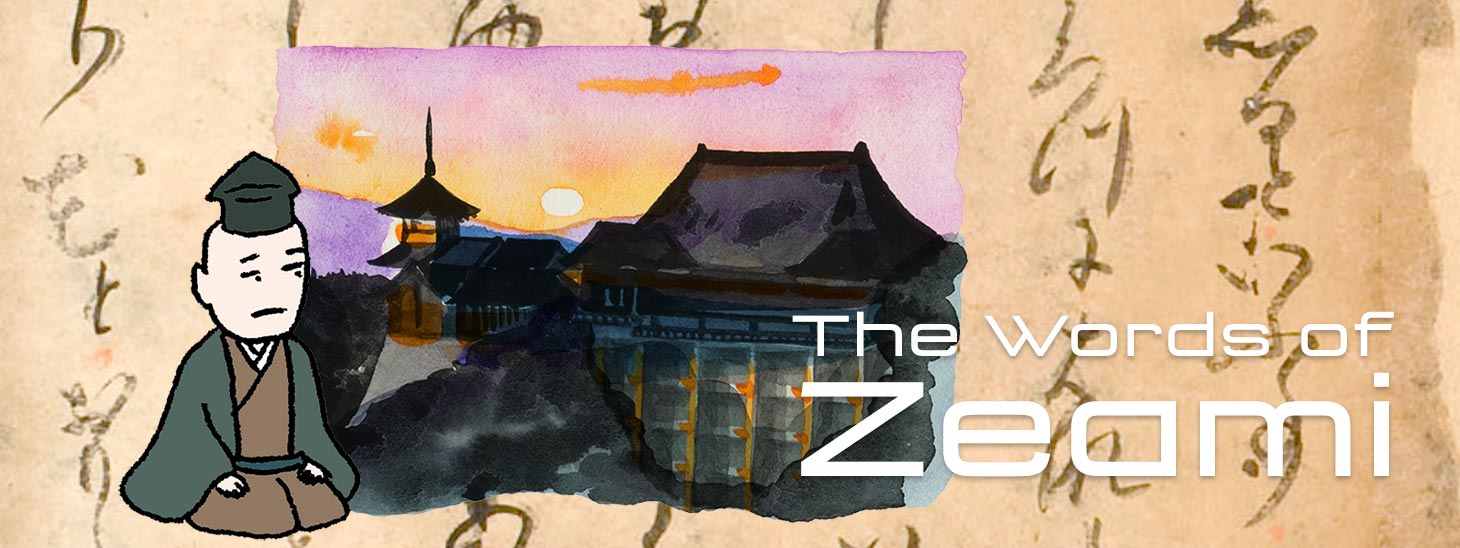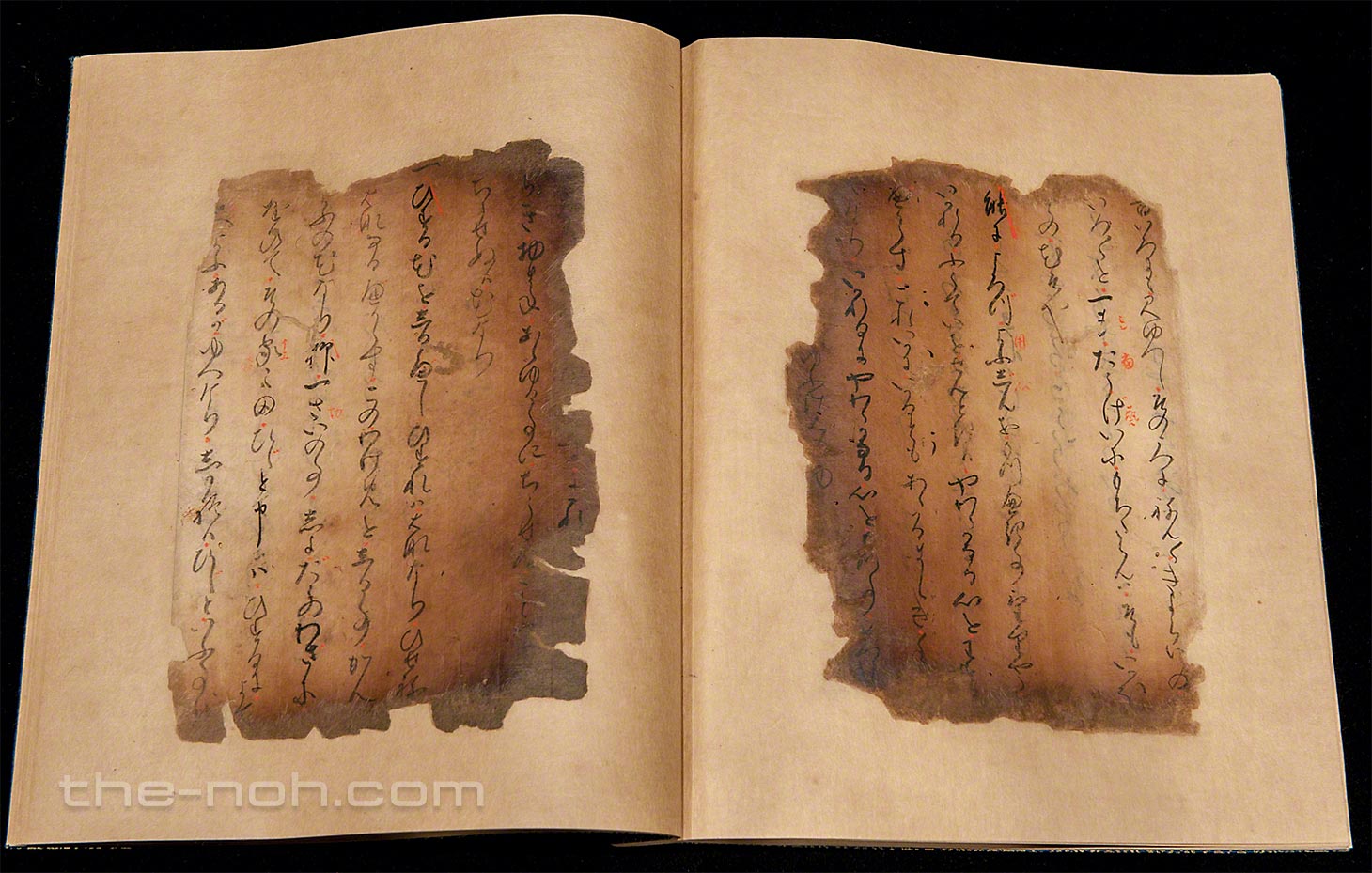
 |  |  |
| | Home | The Words of Zeami |
 His Dramatic Life
His Dramatic Life

Although Zeami is credited with having perfected Noh as it exists today, his book “Jūroku-bu-shū” was not discovered until 1883 (Meiji 16). Until that time, this historical genius of Japanese culture, whose talent was equivalent to that of Sen no Rikyu, the founder of the tea ceremony, and Basho Matsuo, a haiku poet, had been forgotten not only among the public but also even among Noh performers.
The gem-like words Zeami left for posterity show us his sharp insight into the art of performance as well as into society. Beyond the bounds of the centuries, his words impress us, living in the twenty-first century, and provide wisdom on how to live in modern life.
His Dramatic Life
Zeami was born in 1363, during the Namboku-cho era, as the oldest son of Kannami, who was the favored star in the Yamato-yoza (four sarugaku performance groups in the Yamato region). His childhood name was Oniyasha, and his true name was Motokiyo.
When he was eleven years old, he performed the role of shishi (a lion) with his father in a Noh performance competition in Imakumano. Beginning with this performance, Zeami was recognized for his talents and became a star actor. Also, at this performance, he met the young shogun of the Muromachi Shogunate, Yoshimitsu Ashikaga, and was invited to serve Yoshimitsu intimately thereafter. Yoshimoto Nijo, who was the most sophisticated members of the culturati of that time, also favored Zeami and provided him with the knowledge of Japanese classics, such as the Kokinshū and renga poem (linked verse).
In Zeami's day, the shogun and aristocrats were quite important as patrons for newly emerging arts. Therefore, it was a great opportunity for Kannami and Zeami to be recognized by the shogun. Regarding his relationship with Yoshimitsu as a “peg boy,” Masako Shirasu, a writer who also learned Noh, notes in her book “Zeami,” that “pederasty was neither unusual in Zeami's time nor considered unhealthy as it is today. It was not considered sexual degeneracy but rather was the extreme expression of the attachment between master and apprentice. Ancient Japanese pederasty did not seek feminine beauty in naive boys but recognized boys as the symbol of youth and beauty and sought the ideal of maleness within them. Among Buddhism monks, there was a story of a monk who decided to enter the priesthood because he found a personified Kannon (Deity of Mercy) within a beautiful boy.” She continues that “Zeami was not a person who indulged himself in the love of Yoshimitsu. He was a clever boy full of curiosity. In his writings, he showed his appreciation for his debts to Yoshimitsu, but he was not particularly boastful of his relationship with the shogun, and of course he did not attempt to take advantage of the shogun's patronage.”
Shortly after Zeami turned twenty, his father, Kannami, passed away while he was traveling for a performance in Suruga (in present-day Shizuoka Prefecture). From that time on, Zeami became the leader of the Kanze group in deed and in name and managed the group as the shite, who was the stage director and the protagonist. He arranged and improved his father's repertory dramas as well as created many new Noh dramas.

Fushi Kaden, Volune 7, Besshi Kuden, written by Zeami in the middle of the Oei period (1394-1428). It is believed to have survived a fire at the Kanze home in the 16th century. Photos: Shigeyoshi Ohi
Although enjoyed favor in his own life, he suffered over the matter of choosing a successor. Since he was not blessed with a child, he adopted a child, so-called Onnami, who was a son of Zeami's younger brother, Kanze Shiro, Zeami started to think of carrying on the tradition of his performance art and to write “Fūshi kaden.” This was a sort of guide written for his successors to sustain the highest status in the world of Noh, while it is recognized as a book of quintessential art theory today.
Zeami and his wife were finally blessed with three children, the oldest son, Juro Motomasa, the second son, Shichiro Motoyoshi, and a daughter, who later became the wife of Komparu Zenchiku. Zeami suffered between favoring his blood-related son, Motomasa, and favoring the Shiro/Onnami family since Onnami, Zeami’s nephew and adopted son, was once determined as his successor. Ultimately, Zeami handed down the “Fūshi kaden” to Motomasa, when it was completed in 1418.
Although Zeami was once favored by the shogun Yoshimitsu, their relationship changed over the years. Yoshimitsu came to favor Zeami’s rival Noh actor, Inuoh, in his last years and ranked “Dohami (Inuoh) as the best sarugaku actor.” However, after Yoshimitsu’s sudden death from illness, Yoshimochi, who was a member of the culturati and familiar with Zen Buddhism, became the next shogun. The new shogun favored Zohami, a dengaku actor, instead of Dohami.
In 1428, Yoshimochi died and Yoshinori became the sixth shogun. Zeami’s adopted son, Onnami, performed the grand Noh performance for Yoshinori’s accession to shogun, instead of Zeami. From there on, Onnami became the leader of the Noh world, and the Kanze group split into the mainstream of the Onnami group and the anti-mainstream of the Zeami and Motomasa group. Around this period, Zeami’s second son, Motoyoshi, entered the priesthood probably out of despair regarding his future. Two years later, the first son, Motomasa, passed away in his early thirties while performing in Ise (in current Mie Prefecture).
After losing his successor Motomasa, Zeami mentally relied on Komparu Zenchiku, his son-in-law. In his very last years, Zeami passed down “Noh as a philosophy,” including the theory of Noh performance, to Zenchiku.
During such a period, another ordeal came to Zeami. In 1434, seventy-two-year-old Zeami was suddenly expelled from the capital city of Kyoto and was banished to Sado Island (in present-day Niigata Prefecture). It is unknown why the government expelled him because no official record was left about his exile. The fact is barely known through the existence of his letters to Zenchiku and “Kintoh-sho,” his travel notes from Sado.
In 1441, the sixth shogun, Yoshinori, was murdered, and Yoshimasa Ashikaga assumed the position of the eighth shogun. Onnami however maintained his privileged star position. The current Kanze School is the lineage of Onnami.
No one knows when and where Zeami passed away. According to the tradition of the Kanze family the date was 1443. If this is true, he was eighty-one years old at his death. It is said that he probably died in Sado Island.